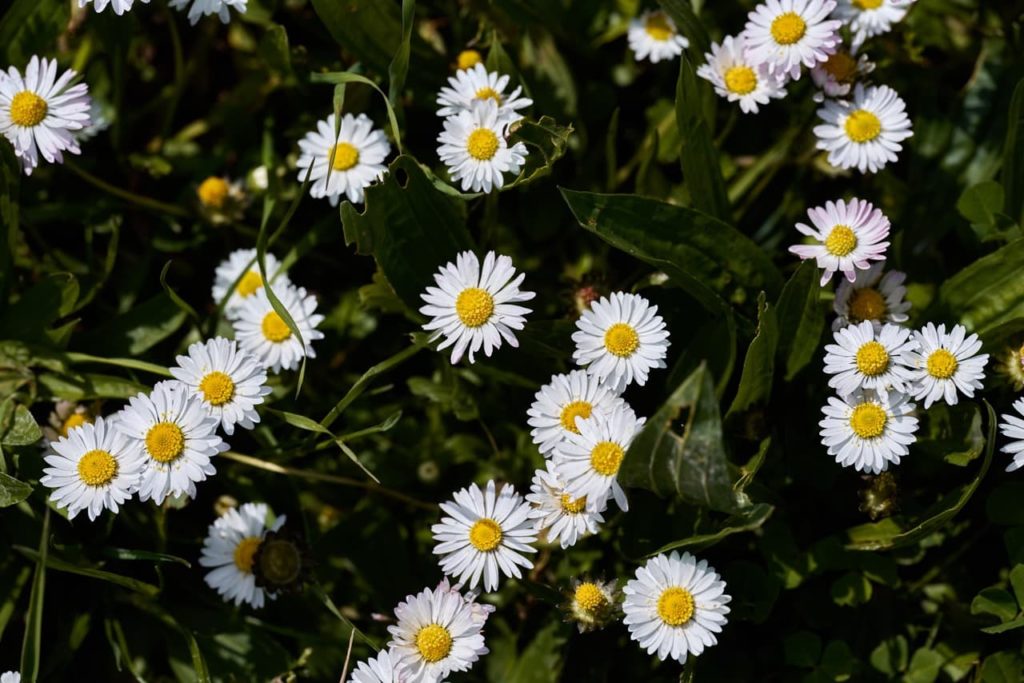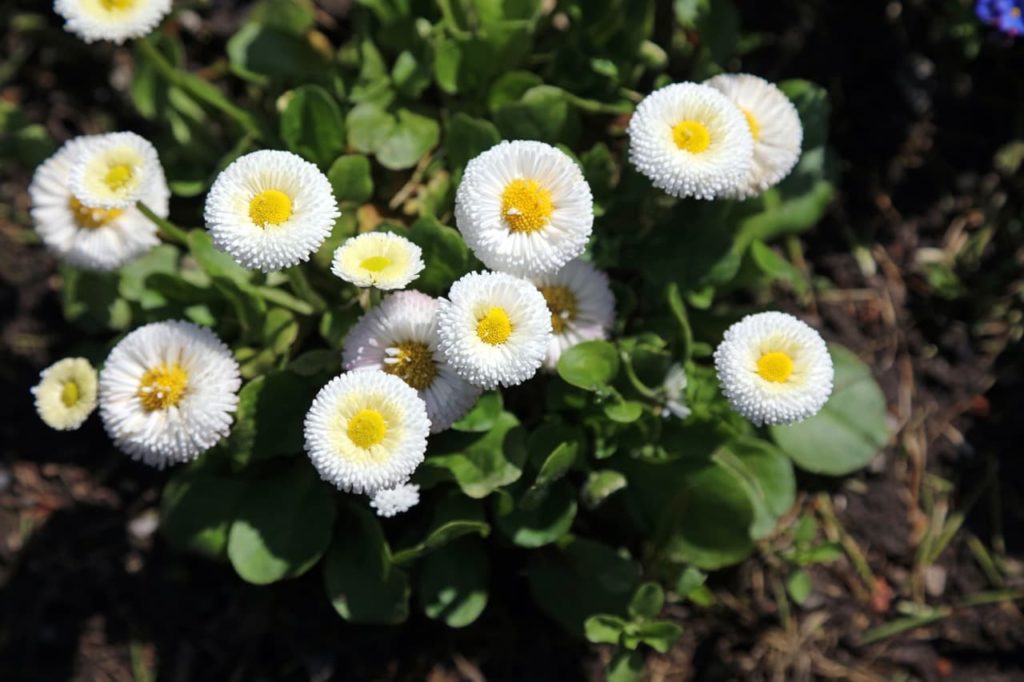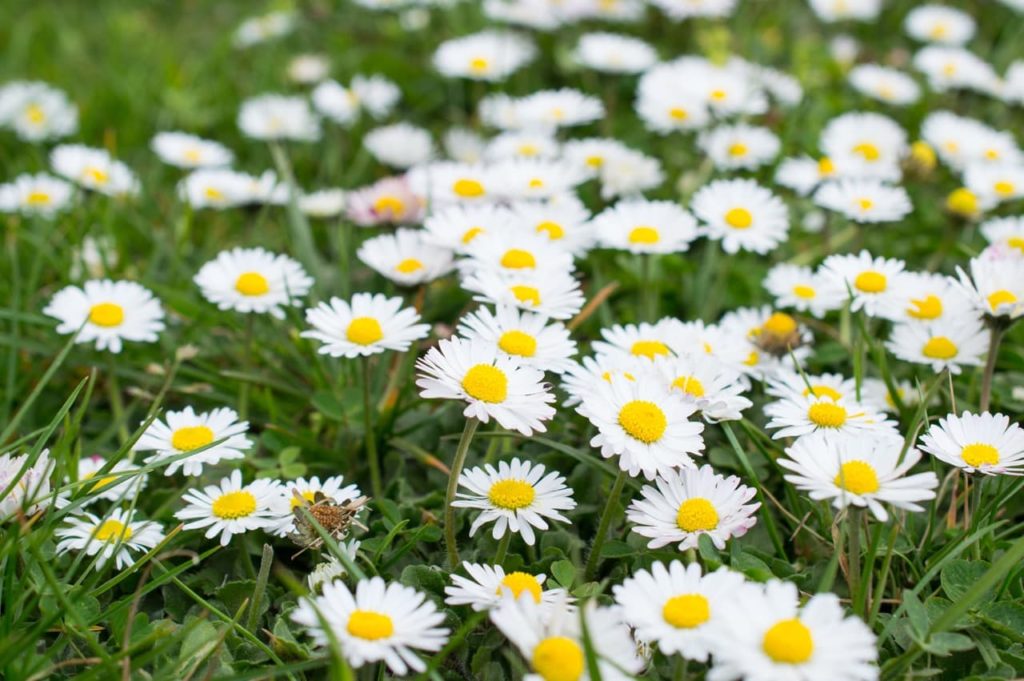PERENNIALS > DAISY

Elizabeth is a Permaculture Garden Designer, Sustainability Consultant and Professional Writer, working as an advocate for positive change. She graduated from the University of St. Andrews with an MA in English and Philosophy and obtained a Diploma in Applied Permaculture Design from the Permaculture Association.
Reviewed By DAN ORI

Dan has over 27 years’ under his belt caring for plants and gardens. Working as a Horticultural Instructor and Consultant, he draws on a diverse range of experience that includes working as a Head Gardener, Tree Surgeon, Garden Centre Trouble Shooter, and writer of academic papers. Dan has a Level 3 Diploma in Horticulture and is currently a candidate for the RHS’s most prestigious award – The Master of Horticulture.
Daisies are one of the native plants with which most people are extremely familiar.
They are an important part of British childhood and many will remember sitting on the grass and making daisy chains as a child.
There are common daisies growing in many lawns and wildflower meadows across the UK and also many cultivars derived from this native wildflower that offer bedding plants for a range of different growing schemes.
Even though it is so common, the common daisy still has the capacity to surprise and there are many things about these cheerful little flowers that you might not know.
Overview
| Botanical Name | Bellis perennis |
| Common Name(s) | Common Daisy / Lawn Daisy |
| Plant Type | Perennial |
| Native Area | Europe, including the UK |
| Hardiness Rating | H5-H7 |
| Foliage | Evergreen |
| Flowers | White petals, yellow centres, pink-tinged edges |
| When To Sow | June – July |
Sunlight
Preferred
Full sun or part shade
Exposure
Exposed or sheltered
Size
Height
0 – 0.1M
Spread
0 – 0.1M
Bloom Time
March to August
Soil
Preferred
Most fertile soils
Moisture
Moist but well-drained or well-drained
pH
Any
Bellis perennis, the common daisy, lawn daisy or English daisy as it is sometimes known, is a common native wildflower and often grows in lawns in British gardens.
It is native to western, central and southern reaches of Europe but has now become widely naturalised in most temperate climate regions.1Bellis perennis. (n.d.). Kew Royal Botanic Gardens. Retrieved July 7, 2023, from https://powo.science.kew.org/taxon/urn:lsid:ipni.org:names:184409-1
Even those very familiar with these daisies are surprised to learn that they are edible.

The young leaves of these daisies can be eaten raw in salads or cooked, though they can get somewhat astringent or bitter as they age.2Common Daisy, Bruisewort, Bellis perenis. (2022, April 28). Wild Food UK. Retrieved July 7, 2023, from https://www.wildfooduk.com/edible-wild-plants/daisy/
In the garden, daisies can be great additions to a wild lawn or perennial wildflower meadow.
They also look good at the front of borders, along pathway edges or in rockeries, and can find a place in a huge range of different planting schemes.
Common Daisy Varieties
Other than the species type, some interesting Bellis perennis varieties to grow include:
B. perennis ‘Tasso’ Series

B. perennis ‘Romi’ Series

B. perennis ‘Roggli’ Series

B. perennis ‘Dresden China’

B. perennis ‘Pomponette Mixed’

A few other common varieties whose names you might recognise:
- B. perennis ‘Belissima’ Series
- B. perennis ‘Lower Minety’
You will find that Bellis daisies come in a wide range of different colours and styles of bloom.
Many of the above have double flowers that are considered attractive, but remember that double flowers will not generally be as good for the pollinators and other wildlife in your garden as the single-flowered types.
These cultivars, like the common daisy, are naturally perennial, but they are often treated as biennials in a garden setting.
How To Grow Lawn Daisies
These daisies are remarkably easy to grow, whether we are talking about allowing the wildflower to proliferate in a grassy area or cultivating varieties of this species in flower beds or borders.
Of course, you do need to provide the right growing conditions in order for these flowers to thrive.

Remember to make sure that there is enough sunlight and that the soil conditions are free-draining, as these are really the most important things when growing daisies in your garden.
Sowing
These daisies’ seeds are best sown when they mature after flowering, in June or July.
The seeds are typically sown where they are to grow, sometimes as part of a wildflower mix.
Bellis perennis and cultivars of this wildflower often self-seed readily, so once you have them in your garden, you should find that they can spread without your intervention.
However, double flowers may sometimes revert to single blooms when self-seeded.
Planting Out
Bedding-type Bellis perennis cultivars are typically planted out into beds or borders between March and May.

These hardy plants can also be planted out in autumn to overwinter before flowering the following spring.
Plant Bellis perennis in full sun or partial shade – not in too shaded a position.
Soil Requirements
When choosing where to sow or plant Bellis perennis, you also need to think about the soil.
Fortunately, these plants are relatively unfussy and they do not mind about soil type or pH levels.
However, they do require relatively free-draining conditions and do not like saturated conditions or waterlogging.
Daisy Plant Care
Not much care is required when growing common daisies in a UK garden.

The natural native species type will thrive on its own with little to no care and attention from the gardener.
Watering & Feeding
Daisies can typically thrive with natural rainfall in the ground and will only need additional watering when grown in pots or during prolonged dry spells.
For these low-maintenance plants, feeding is not generally required when growing in the ground.
However, to promote good flowering, especially if growing in pots, it is a good idea to feed every couple of weeks with an organic, potassium-rich, liquid plant feed.
Pruning
No pruning is required when growing native lawn daisies, but if you are growing the bedding type, you may choose to cut back after flowering has come to an end for aesthetic reasons.

You may wish to deadhead the flowers if you wish to avoid self-seeding and, in any case, with cultivars deadheading can prolong the blooming period.
Dividing
These daisies can be propagated by means of division, which will also help you to avoid the congestion of existing clumps.
You can divide daisies in the autumn after flowering or you can divide the plants during the spring, from March to May.
Winter Care
Bellis perennis are fully-hardy perennials that can easily survive winter in any UK garden.
The species type has an RHS hardiness rating of H7.

They will typically (though not always) die back in the winter, but will burst into new growth in the following spring.
Common Problems
Daisies are generally free from pests but can be infected by rust.
You should generally find that as long as you care for your plants correctly and have positioned them in a suitable location, they are relatively easy and problem-free plants.
FAQs
Is Bellis perennis Invasive?
Common lawn daisies were historically often viewed as weeds in a lawn, but there is an increasingly good understanding in the UK that a manicured lawn is not an eco-friendly or sustainable choice and that daisies and other wildflowers are welcome additions.

However, they are a valuable native species in the UK, but outside of their range they can be detrimental as non-native, invasive plants.
“If you keep a manicured lawn and like your plant beds weed-free, Bellis perennis may not be something you want to encourage in your garden due to its invasive nature,” shares Master Horticulturist Dan Ori.
“You may find a cultivated variety of Bellis that can be grown in a pot and deadheaded would be a better option.”
Are All Bellis Plants Perennials?
Bellis perennis is perennial, but as mentioned above, many cultivars derived from this species, known as bedding Bellis daisies, are treated as biennials in a garden.
Still, when left to grow in a garden, they are technically still short-lived perennial plants.
References
- 1Bellis perennis. (n.d.). Kew Royal Botanic Gardens. Retrieved July 7, 2023, from https://powo.science.kew.org/taxon/urn:lsid:ipni.org:names:184409-1
- 2Common Daisy, Bruisewort, Bellis perenis. (2022, April 28). Wild Food UK. Retrieved July 7, 2023, from https://www.wildfooduk.com/edible-wild-plants/daisy/

